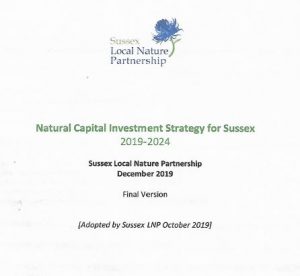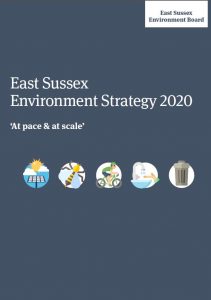ESCC’s Environment Strategy; At pace & at scale’ (2020)
The ESCC Environment Strategy was published in two parts in 2020, the Strategy (16pp) and the Appendix (38pp) dated March 2020 and June 2020 respectively.[1] It replaces the first Environment Strategy for East Sussex adopted in 2011. A lot of rhetoric, national dilemmas, and UK concerns are repeated throughout this document. Turning to East Sussex, it states that 470 species that are globally threatened in the county, or in rapid decline. The Strategy is updated to be in line with the 25 year Environment Plan (2018) and Parliament’s declaration of Climate Emergency in 2019.
The Strategy’s vision is ‘protect and enhance our natural and built environment for current and future generations and tackle and adapt to climate change.’ That is a familiar mantra that goes back decades and is invested in UK law. ‘conserve and enhance’. The Strategy is disappointing in what it does not cover. There are no references to nature conservation or soil conservation, SSSIs, BAPs, Ancient Woodland, Wood-pasture, or surprisingly nothing major on biodiversity. It acknowledges the impact on woodlands in East Sussex (which has more than most counties), especially the impact on associated woodland habitats ‘the loss of valued areas for recreation.’
Natural Capital is mentioned, and is comprehensively dealt with in the Appendix; whilst everyone is nervously awaiting the result of the Environment Bill in its final deliberation on net gain in which way to jump. Nationally, it is interesting to note that OFWAT are aiming to ‘protect and improve at least 6,000km of waterways, and protect and improve 1,800ha of protected nature conservation sites by 2025. One hopes this will trickle down to East Sussex. This will clearly be a rolling strategy for East Sussex, but the document as presented, does not have a functioning feedback email address, and the Team Manager is aware of the various typos and states that further information on nature conservation is to be found in the Sussex Local Nature Partnership document ‘Natural Capital Investment Strategy for Sussex 2019-2024.’ At present, it is a disappointing document.
[1] East Sussex County Council, 2020. Is in two parts i) ‘The Environment Strategy’, dated March 2020 (16pp) and ‘The Technical Appendix to the Environment Strategy’, dated June 2020 (38pp).
https://www.eastsussex.gov.uk/media/15587/east-sussex-environment-strategy-2020.pdf
https://www.eastsussex.gov.uk/media/15589/east-sussex-environment-strategy-2020-technical-appendix.pdf (accessed 01 December 2020).
Note: The above ESCC Environment Strategy 2020 relies upon the following publication for nature conservation issues, facts and figures.
Natural Capital Investment Strategy for Sussex, 2019-2024. Sussex Local Nature Partnership, December 2019. Final Version. (adopted by Sussex LNP October 2019). 73pp. 
Twenty-four Sussex Local Nature Partners (SLNP) participated in drawing together this 73pp compilation of Natural Capital Investment Strategy in Sussex. Both East and West Sussex are lumped together, and obvious nature conservation groups have been involved such as Sussex Wildlife Trust, CPRE, CLA, EA, NE, NFU, SDNPA, ESCC (but no LPAs). This reviewer has been told (Dec 2020) by the on-line administrator of The ESCC Environment Strategy 2020 that it relies upon this document for all the information on nature conservation that is not within the Environment Strategy. It is just over a year since this document was produced (adopted by SLNP October 2019), but it still has not published the assets that it is still counting up. Sussex’s assets are its habitat types, and this document lists these which it classifies as ‘natural capital asset types.’ The assets it is relying on are on page14, which lists, for instance four types of Ancient Woodland.
However, it does not list ‘Wood-pasture & Parkland BAPs’ which are Priority BAPs – a serious error. These are associated woodland habitats of ancient woodland recognised by Natural England. There is a risk that the eventual quantum of assets will only be based on some of the statutorily protected areas such as NNRs, SSSIs, SACs, SPAs and Ramsars whilst other important habitats, protected by other statutory instruments will not be represented in the overall audit.
The omission is replicated in Table 2a (p.68) ‘Terrestrial Assets’, where at risk habitats are highlighted in red. They do note that woodland is under risk of ‘loss of valued areas for recreation’. There is not a word about ‘Wood Pasture and Parkland BAPs’. It is as if the law embedded in NERC (2006) – a statutory act – is not recognised.
The report has produced various useful maps across Sussex (too small to expand) and an intriquing ‘Woodland Heathmap’. This shows that there are three areas across the Sussexes, one in the east, one in the north central area of Sussex and one in the east. This is where there are:
‘existing woodland concentrations in Sussex,’ In these areas what is proposed is ‘In terms of biodiversity benefit, new woodland plantings regeneration in the areas of high woodland concentration can be used very beneficially to expand and connect woodland fragments and thus strengthen woodland ecological works.’
Alarmingly, the document states that ‘At time of writing this strategy, no ‘valuations’ have yet been published for the natural capital of Sussex.’ (http://sussexlnp.org.uk/what-is-natural-capital/). This is a concerning relevation. Without any valuations there can be no informed or considered view, so the report is not supported by any evidence. Valuations are awaited to inform the strategy in Sussex, whilst the climate emergency continues.
There are some inherent downfalls in calculating nett gain for the nature conservation, as RSPB points out that removing an ancient woodland to make way for conifers that do a good job in carbon sequestration, plus providing BMX tracts of recreational value, may improve the economic value, but the irreplaceable loss of ancient woodland cannot be quantified. (RSPB (2017) Accounting for Nature: A natural capital account of the RSPB’s estate in England.). Not that anyone is proposing to remove ancient woodland in Sussex, but in other parts of the country the removal of ancient woodland for HS2 has in part been mitigated by replanting.
So, nature conservation in both the Sussex counties is currently held in the balance, whilst the parameters for calculating the assets that the counties are decided. SLNP have not taken Sussex a step forward in knowing what to protect, only advising of the concern that the climate emergency has promoted. Thus no hope at this stage that the definitive quantitative work for Sussex can seemlessly be slotted into the demands of the Environment Act when it lands on our tables in 2021. Until their valuations are complete they cannot inform the direction to take to address the climate emergency.
